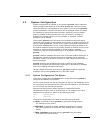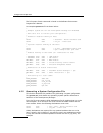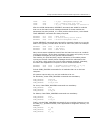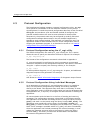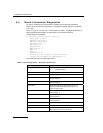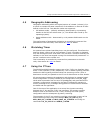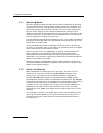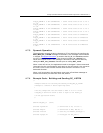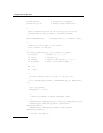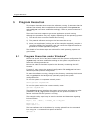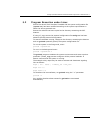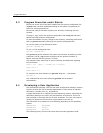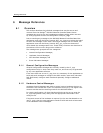
Dialogic
®
DSI SPCI Network Interface Boards Programmer's Manual Issue 5
29
LIU_SC_DRIVE 0 0 512 0xfffefffe * 30 E1 voice ccts on ts 1..15 &
17..31
LIU_SC_DRIVE 0 1 542 0xfffefffe * 30 E1 voice ccts on ts 1..15 &
17..31
LIU_SC_DRIVE 0 2 572 0xfffefffe * 30 E1 voice ccts on ts 1..15 &
17..31
LIU_SC_DRIVE 0 3 602 0xfffefffe * 30 E1 voice ccts on ts 1..15 &
17..31
LIU_SC_DRIVE 1 0 632 0x00fffffe * 23 T1 voice ccts on timeslots
1..23
LIU_SC_DRIVE 1 1 655 0x00fffffe * 23 T1 voice ccts on timeslots
1..23
LIU_SC_DRIVE 1 2 678 0x00fffffe * 23 T1 voice ccts on timeslots
1..23
LIU_SC_DRIVE 1 3
701 0x00fffffe * 23 T1 voice ccts on timeslots
1..23
4.7.3 Dynamic Operation
The application controls dynamic changes to CT bus switching by sending the
MVD_MSG_SC_LISTEN message to the board. This message is documented
in chapter 5 Program Execution
. It contains the liu_id, the timeslot number
on the T1/E1 interface and the CT bus channel number (sc_channel) to
which the timeslot listens. The message is directed to the correct board by
calling the GCT_set_instance function prior to calling GCT_send.
When a new call arrives, the application needs to instigate 2 listen commands
(although they do not necessarily both apply to the SS7 board). One connects
the voice circuit in the forward direction and the other connects it in the
backward direction.
When a call terminates, the application must issue a fixed data message to
ensure the network port sees the voice idle pattern.
4.7.4 Example Code - Building and Sending SC_LISTEN
/*
* Example function for building and sending an MVD_MSG_SC_LISTEN
* message to a SPCI2S or SPCI4 signalling board.
*
* The only change that the user needs to make is to fill in the
* OUR_MOD_ID definition below so that is equal to the module_id
* of the application module.
*/
#define OUR_MOD_ID (0xef)
#include "system.h" /* Definitions of u8, u16 etc */
#include "msg.h" /* Definitions of HDR, MSG etc */
#include "libc.h" /* Used only for memset prototype */
#include "sysgct.h" /* Prototypes for GCT_xxx */



